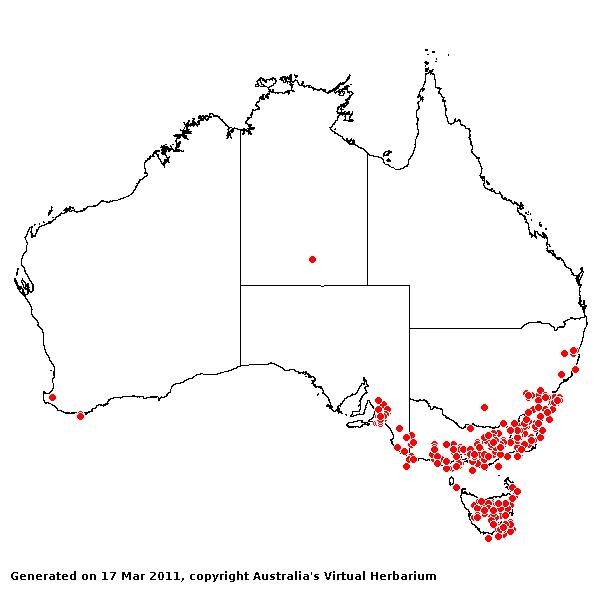Agrostis capillaris* L. Sp. Pl. 62 (1753).
Classification. (GPWG 2001) : Subfamily Pooideae.
Tribe Poeae.
Common name:
Browntop Bent.
Type of Basionym or
Protologue Information: LT: Herb. A. van Royen, (L-912.356–69
(left-hand specimen); ILT: L). LT designated by Widen, Fl. Fenn. 5: ?
(1971).
Recent synonyms:
A. tenuis Sibth., A. tenuis
Sibth. var. aristata (Parn.) Druce.
Key references
(books and floras): [1952] C.A.Gardner, Flora of Western Australia 1
Gramineae (155 as A. tenuis), [2002] D.Sharp & B.K.Simon, AusGrass,
Grasses of Australia, [2006] J.Jessop, G.R.M.Dashorst, F.M.James, Grasses
of South Australia (183), [2002] J.Wheeler, N.Marchant & M.Lewington,
Flora of the South West (395), [2008] S.W.L.Jacobs, R.D.B.Walley &
D.J.B.Wheeler, Grasses of New South Wales (109), [2009] A.Wilson (ed.). Flora
of Australia, Vol 44A. Poaceae 2 (166).
Illustrations:
[2002] D.Sharp & B.K.Simon, AusGrass, Grasses of Australiia, [2006]
J.Jessop, G.R.M.Dashorst, F.M.James, Grasses of South Australia (183, fig.131), [1994] N.G.Walsh, Flora of
Victoria 2, [2008] S.W.L.Jacobs, R.D.B.Whalley & D.J.B.Wheeler, Grasses
of New South Wales, 4th edn (109), [2009]. A.Wilson (ed.), Flora of
Australia 44A: Poaceae 2 (168, Fig.25).
Derivation:
from the Latin capillis (a hair) and -are (pertaining to).
Inflorescence with filiform branches.
Habit.
Perennial. Rhizomes present, elongated. Stolons absent or present. Culms erect
or geniculately ascending, 10–70 cm tall, 2–5 -noded. Leaf-sheaths smooth.
Ligule an eciliate membrane, 0.5–2 mm long (shorter than wide), truncate or
obtuse. Leaf-blades flat or involute, 1–15(–20) cm long, 1–5 mm wide.
Leaf-blade surface smooth or scaberulous.
Inflorescence.
Inflorescence compound, a panicle. Panicle oblong to ovate, 1–20 cm long, 1–12
cm wide.
Spikelets.
Spikelets pedicelled. Fertile spikelets 1-flowered, comprising 1 fertile
floret(s), without rachilla extension, lanceolate or oblong, laterally
compressed, 2–3.5 mm long.
Glumes. Glumes
similar, firmer than fertile lemma, shiny. Lower glume lanceolate, membranous,
keeled, 1-keeled, 1 -nerved. Upper glume lanceolate, membranous, keeled,
1-keeled, 1 -nerved.
Florets.
Fertile lemma 1.2–2.7 mm long, without keel, 3–5 -nerved. Lemma surface glabrous.
Lemma apex entire or dentate, muticous or awned. Median (principal) awn dorsal.
Palea 2 -nerved. Lodicules present. Anthers 3. Grain 1 mm long.
Continental
Distribution: Europe, Africa, Temperate Asia, Tropical Asia, Australasia,
Pacific, North America, South America, and Antarctica.
Australian
Distribution: Western Australia, South Australia, New South Wales,
Victoria, Tasmania.
Western Australia:
Dale. South Australia: Murray, Southern Lofty, South-eastern. New
South Wales: Central Coast, South Coast, Northern Tablelands, Central
Tablelands, Southern Tablelands, Central-Western Slopes. Victoria: East
Gippsland, Eastern Highlands, Gippsland Plain, Grampians, Lowan Mallee,
Midlands, Murray Mallee, Snowfields, Wimmera. Tasmania: Furneaux Group,
North West, North East, West Coast, Central Highlands, Midlands, Ben Lomond,
East Coast, South West, Mt Wellington.
Notes. A major turf
species (lawns and sports turf) in the cooler parts of Australia. Also a major
weed of pastures especially in areas of low soil fertility.
Introduced. Occurs in temperate
Australia. Native to Europe, now widely naturalized. Common as a weed of
pastures and roadsides and invading native herb and grassfields in highland
areas. Occurs mainly on poor, acidic soils. Flowers Nov.-Feb.
Infra -specific taxa: var. capillaris, var. aristata.
Lemma awnless A. capillaris var. capillaris
Lemma shortly awned A. capillaris var. aristata





